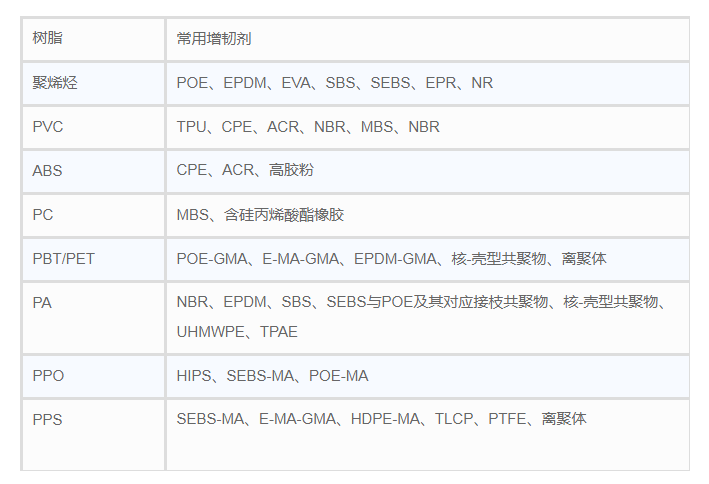








keyword:plastic processing company plastic masterbatch modification of plastics Dyeing of plastics melt blown polypropylene special plastics for animal husbandry
Home,Special material series for animal husbandry products,In-depth discussion, the toughness, rigidity, and impact resistance of plastics

 2021.07.16
2021.07.16 Yishibao Plastics
Yishibao Plastics
"Rigidity" refers to the amount of force required for an object to undergo unit deformation; "flexibility" refers to the amount of deformation of an object under unit force. The greater the "rigidity", the less likely to be deformed; the greater the "flexibility", the easier it is to deform. Materials with good toughness are softer, with higher tensile elongation at break and higher impact strength, but lower hardness, tensile strength and tensile modulus of elasticity.
It can be seen from the above description that stiffness and toughness are opposite, but for modified plastic products, the two are interdependent. For example, after using glass fiber reinforced plastics, while its rigidity increases, both tensile strength and impact strength may increase.
How to improve plastic toughness
Through the test of plastic products, it is found that improving the toughness of the matrix resin is beneficial to improving the toughening effect of the toughened plastic. There are many ways to toughen, such as increasing the molecular weight of the matrix resin to narrow the molecular weight distribution, or controlling the crystallinity and crystallinity, crystal size and crystal form to improve toughness.
How to distinguish the commonly used tougheners for plastics?
Toughened rubber elastomer
EPR (ethylene propylene diene monomer), EPDM (ethylene propylene diene monomer), butadiene rubber (BR), natural rubber (NR), isobutylene rubber (IBR), nitrile rubber (NBR), etc.; suitable for the increase of all plastic resins Toughness modification
Toughened by thermoplastic elastomer
SBS, SEBS, POE, TPO, TPV, etc.; mostly used for the toughening of polyolefins or non-polar resins. When used for toughening polymers containing polar functional groups such as polyesters and polyamides, a compatibilizer must be added;
Toughening of core-shell copolymers and reactive terpolymers
ACR (acrylic esters), MBS (methyl acrylate-butadiene-styrene copolymer), PTW (ethylene-butyl acrylate-glycidyl methacrylate copolymer), E-MA-GMA (ethylene-acrylic acid) Methyl ester-glycidyl methacrylate copolymer), etc.; mostly used for toughening engineering plastics and high temperature resistant polymer alloys;
High toughness plastic blending toughening
PP/PA, PP/ABS, PA/ABS, HIPS/PPO, PPS/PA, PC/ABS, PC/PBT, etc.; polymer alloy technology is an important way to prepare high toughness engineering plastics;
Toughened in other ways
Toughening of nanoparticles (such as nano-CaCO3), toughening of sarin resin (DuPont metal ionomer), etc.

In principle, the essence of toughening can be said to be compatibilization. If the toughening agent is regarded as a type of polymer, this principle of compatibilization can be extended to all polymer blends. When preparing useful polymer blends in industry, reactive compatibilization is a technology that we must use. Therefore, toughening agents have different meanings. It is precisely this way that "toughening compatibilizers" ", the image title of "Interface Emulsifier"!
How to improve impact resistance
As an engineering plastic, we hope it has good toughness and rigidity at the same time. When improving the toughness of the material, we should also try to increase the rigidity.
Under normal circumstances, the rigidity can be increased by adding inorganic fillers. But the most effective method is to combine the toughening of the elastomer and the reinforcement of the filler.
Poor impact resistance is a performance defect of some important plastics in the industry. Such as PVC, PS, PP, etc., especially at low temperature due to low impact resistance, which limits their application. However, in thermoplastics, their impact resistance can be greatly improved by adding "impact modifiers".
Varieties of impact modifiers:
Commonly used are ACR-acrylate resin, MBS-methyl methacrylate-butadiene-styrene copolymer, CPE-chlorinated polyethylene, ABS, EVA, EPT-ethylene propylene rubber and so on.
From the perspective of the modification effect of plastic products, ACR is the category with the best overall performance;
MBS is an important impact modifier for transparent products and occupies an important position in the global impact modifier market.
Although impact modifiers can increase impact strength, they have an adverse effect on other mechanical strengths.
If MBS is added to PVC, the tensile strength and bending strength are reduced. The addition of ACR will also reduce the tensile strength, hardness and Vicat heat resistance of HPVC-high molecular weight PVC. The addition of CPE also reduces the tensile strength, bending strength and Vicat softening point of the blend. Therefore, other properties must be taken into consideration when using impact modifiers. To determine the appropriate dosage.
key words:impact resistance of plasticsChina impact resistance of plasticsQingdao Yishibao Plastic Co., LTD
133 9532 2932 / 133 0639 9338
+86-532-8790 1798
qdyishibao@126.com
www.ysbplastics.com
Zaohu Community , Chengyang Street ,
Chengyang District , Qingdao City
133 9532 2932 / 133 0639 9338

Online
Message
©Copyright Qingdao Yishibao Plastic Co., LTD., 2024
Technical Support:E-shine